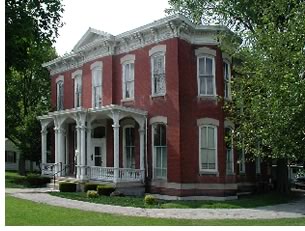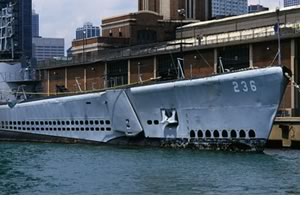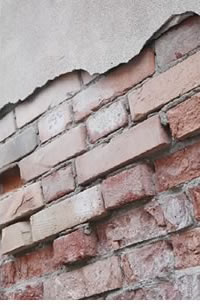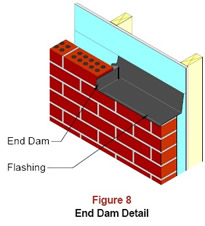

2/2006

by Grant A. Simpson, FAIA, and James B. Atkins, FAIA
Ooh, a storm is threatening my very life today,
If I don’t get some shelter, oh yeah I’m gonna fade away
—The Rolling Stones, 1969
Our professional lives are threatened today by moisture intrusion. Professional liability insurance specialist Victor O. Schinnerer reports that almost one quarter of claims against insured architects allege problems with waterproofing or a component of the building exterior closure. Many of these claims are related to failures in the exterior wall. These failures generally result from water intrusion directly through the wall and water vapor transmission and condensation on or within the wall. When unwanted water and water vapor come in contact with materials and finishes not designed to resist or accommodate moisture, damage occurs. The end result can include staining, material degradation, mold, and lawsuits.
The rain in Spain falls mainly on the buildings
What is it about water and the exterior walls that both designers and
builders are struggling with today? In the industry there seems to
be more maneuvering to manage risks or blame others than efforts spent
designing and building exterior walls that accommodate and manage moisture.
This includes architects, constructors, manufacturers, and suppliers.
Have we forgotten that water runs downhill, wind-blown rain runs uphill,
and moisture condenses on cool surfaces? Are we no longer aware that
humidity is a real problem in hot, humid climates? Have we forgotten
how to “shingle” surfaces to shed water?
 Perhaps in earlier times there was a greater tolerance for the impact
of infiltrated water and the condensation of moisture. It could be because
water did less damage to the materials used in the past. When older buildings
are renovated today, it is common to “discover” that special
measures must now be taken to control humidity that is resulting from
vapor transmission. It is also common to “discover” that
years of moisture seeping into the exterior wall has rusted or rotted
windows and doors and other wall materials, especially in older wooden
or masonry structures. Moisture often infiltrates old exterior masonry
walls and resides within, doing so little visible damage that it is tolerated.
Have you ever noticed a “musty” smell in an older building,
perhaps like your town’s city hall? That “musty” smell
can get you sued in a modern building.
Perhaps in earlier times there was a greater tolerance for the impact
of infiltrated water and the condensation of moisture. It could be because
water did less damage to the materials used in the past. When older buildings
are renovated today, it is common to “discover” that special
measures must now be taken to control humidity that is resulting from
vapor transmission. It is also common to “discover” that
years of moisture seeping into the exterior wall has rusted or rotted
windows and doors and other wall materials, especially in older wooden
or masonry structures. Moisture often infiltrates old exterior masonry
walls and resides within, doing so little visible damage that it is tolerated.
Have you ever noticed a “musty” smell in an older building,
perhaps like your town’s city hall? That “musty” smell
can get you sued in a modern building.
Today’s buildings tend to be built of materials less resistant to the presence of moisture over extended time. Thin sheets of gypsum or plywood serving as substrates behind thin veneers of cement plaster, stone, or masonry simply do not perform well when assaulted by the continuous presence of moisture. So called “barrier” systems composed of coated foam sheets or wood composites that are intended to completely stop water or moisture from infiltrating the exterior envelope rarely survive nature’s continual onslaught.

The art of detailing and correctly installing flashing to control water is mandatory for both constructors and designers if this problem is to be overcome. Even so, it seems that flashing design and construction are not well understood by everyone these days. A better understanding of working with available materials can benefit all involved in the design and construction industry.
This article will address some common issues concerning the exterior wall. We have chosen to focus on this element of the building envelope because of the many problems that arise from misunderstandings, misapplication, and poor workmanship. We will explore actions to take and issues to consider including the possibility that secondary water management may be an idea whose time has come. And in keeping with the spirit of this series, we will relate some opportunities for giving Shelter that are available to the architect as the exterior wall is designed and constructed.
BUILDING ENVELOPE BASICS
It is important that the following basic issues be considered by designers
and builders.
1. Water runs downhill: As simplistic as it is, it often appears that this fact of nature was not a consideration in some building designs. It rains, it snows, and sooner or later water begins its journey downhill. Designs must be created and buildings built mindful of the reality that water will penetrate openings that it can run down into. If you have a design that places a material other than roofing, waterproofing, or flashing in a horizontal plane, then you must carefully consider the design and treatment of that material. Although the material may be typically configured in a horizontal condition, like concrete, metal, or skylights, where and how water runs off of it onto lower surfaces must be thoroughly explored. You must always ask yourself or the contractors the question, “What will happen if water does get through this material or assembly?” You must also ask the corollary question, “Should there be a means to get water that migrates across or through this material or assembly back outside again?”
2. Moisture tends to condense on cool surfaces. Water enters a building even before leaks from rain or snow can arise. That is because water is in the air. This is a complex subject involving weather, humidity, vapor transmission, and vapor retarders, and it transcends the scope of this essay. Nonetheless, designers and builders must have a basic understanding of vapor transition and condensation. Everyone must understand that water vapor “drives” from warm temperatures toward cooler temperatures. Bootleg whiskey runners have developed their finest products from this concept. If moist warmer air comes in contact with a surface whose temperature is at or below the dew point, then moisture will condense on that surface. If that surface is a material that is not designed to withstand encroachment and assault by water, then it will be damaged. Generally, in the winter in most locations, vapor will drive from the interior to the exterior. Conversely, in the summer, it will drive from the exterior to the interior most of the time.
An excellent reference check is a simple calculation performed by a mechanical engineer, commonly called a “Vapor Drive Analysis.” This calculation can help foster an understanding of what portion, if any, of the exterior wall assembly may be subjected to condensation and under what conditions. While the analysis is typically targeted at extreme conditions to which the building is not constantly subjected, nonetheless, the information gained can facilitate the determination of a vapor retarder location and the selection of materials that will not be damaged by transient water on surfaces where condensation will likely occur.
By definition, the permeance of an adequate vapor retarder should not exceed 1 “perm.” Many designers and builders are confused by the dynamics created when vapor retarders are placed in the exterior wall. Not too long ago, prompted by energy-saving concerns, design priorities called for placing an impermeable vapor retarder as close as possible to the interior face of the exterior wall, allowing water vapor in the wall to dry to the exterior. In recent years, this wisdom has changed, suggesting that in some climates it is more appropriate to place the vapor retarder closer to the exterior surface, allowing moisture to dry toward the interior. Moreover, thinking today has evolved to the point that no vapor retarder at all is the recommendation in some climates. Model building codes that require vapor retarders currently are undergoing study to reflect these changes of wisdom.
Vapor retarders may consist of plastic sheets or fluid-applied materials specifically designed and selected for that purpose. Vapor retarders can also be inadvertent, as was the case several years ago when it was discovered that vinyl wall coverings and some types of paint were effectively creating a vapor retarder on the interior face of gypsum wall board installed on an exterior wall. (Note: An excellent source for further reading on current trends in exterior wall design, including vapor retarders for various climates, is the Builder’s Guide series of books by Joseph Lstiburek. These books can be ordered from the Building Science Press.)
3. Buildings leak. Many also believe that buildings do not leak, and they believe that if they do leak, it is because someone has made a mistake. The reality is that materials combined to form an exterior building wall are vulnerable to movement, neglected maintenance, degradation, and substandard workmanship, and leaks can eventually occur even if the water is not evident in the interior space. It is wiser to celebrate the fact that buildings either do, or will, leak than to remain silent and allow innocence to foster unrealistic expectations.
 A case for secondary water
management: Would you put a screen door on a submarine?
A case for secondary water
management: Would you put a screen door on a submarine?
So, the reality is that buildings leak. There is no such thing as a perfect
weather “barrier” design except for a balloon. That’s
because it is hard to get water to leak into an inflated balloon. However,
most building types cannot successfully be constructed like a balloon.
Exterior wall designs that anticipate no moisture intrusion into the
building naturally prove unsuccessful when leaks actually occur. A more
successful exterior wall design is one that anticipates leaks and manages
the moisture by directing it back to the building exterior before it
can reach vulnerable interior materials and cause harm.
Standard of Care: When an exterior wall with no secondary water management system fails and a claim is brought against the architect, plaintiff experts will likely suggest that the absence of a secondary water management system is a violation of the Standard of Care. The Standard of Care for architects may vary in some respects from state to state, and its application in a particular case will depend on the unique facts of that case. All that notwithstanding, the definition included in the Architects Handbook of Professional Practice, 13th Edition reflects basic elements generally accepted around the country: “The architect is required to do what a reasonably prudent architect would do in the same community and in the same time frame, given the same or similar facts and circumstances”
Designing an exterior wall as a weather-barrier system without secondary water management should not be regarded as a de facto violation of the Standard of Care, because architects and builders all over the country routinely design and build exterior walls in this way. Nonetheless, inclusion of this feature will provide added protection against water that will inevitably penetrate into the wall.
Forms of secondary water management: Secondary water management can take many forms. It can be a “drainable” EIFS (exterior insulation and finish systems) in lieu of a barrier system. In a cement-plaster stucco wall, it can be a continuous weather-barrier membrane and flashings installed beneath the stucco veneer. In a masonry veneer wall, it can be through-wall flashings designed to intercept any water that leaks through the veneer. It can also be windows, doors, or other exterior opening systems capable of collecting and managing water through the head, sill, and jambs.
Types of window systems
For purposes of simplifying the discussion of different aluminum and
glass systems in this article, Jerry M. Johnson of Curtainwall Design
and Consulting, Inc, Dallas, addresses them in three generic categories:
1. Storefront systems. These generally have little or no performance characteristics relative to managing secondary water and are only designed to “support glass.” Basically, all companies provide these systems. They are best used for one- or two-story projects, preferably where they are covered by an overhang, or located in interior conditions. Sill pans, internal deflectors, and weep holes can provide some water management. However, for the most part, they are considered to be a barrier system.
2. Window wall systems. Window wall is used in “strip” windows and at “punched” windows. These are a more advanced engineered system that incorporates secondary water and air infiltration management. Unfortunately, during “value engineering” discussions, storefront systems are often proposed as a substitution for a window wall application, because they are less expensive. The key to obtaining the better system is through the specifications. It has been a while coming, but most of the major manufacturers now provide high performance systems with secondary water management built in. Our preference is to call a product “window wall” only if it has high performance (rain screen, air, and wind) and secondary water management.
3. Curtainwall systems. The ability to manage water and the resistance to infiltration rises dramatically with curtainwall (construction vernacular for a wall that spans two floors). By distinction, two-floor-high installations can and have been done with simple storefront systems. A curtainwall is a system that incorporates the rainscreen principal and/or a pressure-equalized chamber and effectively manages both air and water infiltration. Most of the “off the shelf” systems can be adapted to the rainscreen system but not the pressure equalized chamber. Curtainwall includes “captured” (2-sided and 4-sided structural silicone glazed) systems, “stick” (framed on site) systems, “unitized” (shop-glazed and field-set) systems, and panelized systems.
Doing your homework
Some fundamental questions must be answered before designing and building
an exterior wall because of the effect of varying conditions that affect
the wall’s behavior and performance.
 Climate conditions: Where will the building be located? Will it be in
an area where a hot, humid climate or a cold climate prevails? Does it
rain a lot or is it arid? Certain wall systems and materials may not
be appropriate in certain climates. The location of the vapor retarder
or the insulation in the wall cavity may differ from the locations of
your previous projects.
Climate conditions: Where will the building be located? Will it be in
an area where a hot, humid climate or a cold climate prevails? Does it
rain a lot or is it arid? Certain wall systems and materials may not
be appropriate in certain climates. The location of the vapor retarder
or the insulation in the wall cavity may differ from the locations of
your previous projects.
Topographic conditions: Will it be possible to design the site drainage so that water flowing on the site does not encounter the exterior wall? Will waterproofing a portion of the exterior wall be required? Does a portion of the base of the wall need to step up to avoid contact with water on the ground?
Building type and use: A thorough understanding of the building type and use is important. From issues as straightforward as knowing you will waterproof an open parking garage differently than you will a hospital, to those as complex as the selection of permeable interior finishes located on the exterior wall, the building type and use impacts decision making. Below-grade structures have their own set of rules for exterior walls.
Compatibility: Careful consideration is necessary as to compatibility
and integration of the different materials combined to form the exterior
wall. Not all types of sealant are compatible, and some sealants are
not compatible with certain materials. Materials that expand or contract
moderately under varying weather conditions require special detailing
when paired with materials that are relatively stable.
EXTERIOR WALL FUNDAMENTALS
Flashing, barriers, and waterproofing
For purposes of this essay, flashing is considered to be a material,
either rigid or flexible, that spans from the sheathing and extends
through the exterior wall or veneer and terminates in daylight. The
weather barrier and also waterproofing behind a veneer are materials
that are generally not exposed to daylight.
 Veneer basics: masonry and stucco
Veneer basics: masonry and stucco
For both masonry and cement plaster stucco, the exterior veneer that
you can see is not necessarily a weather barrier. The weather barrier
is typically located behind the visible exterior veneer. Masonry usually
incorporates a 1-inch to 2-inch cavity between the back of the masonry
and the face of the weather barrier. With stucco, the finish layers
are usually applied directly to the face of the weather barrier. Masonry
and stucco must be viewed as the permeable materials that they are.
Water penetration through stucco and masonry veneers can be significant,
measured in gallons and not ounces. Some parties believe that properly
installed and cured stucco cladding does not allow water penetration
through the stucco. We believe that it is best to assume the worst,
that there will be cracks and compromised areas of the stucco that
will allow water to leak through to the sheathing.
For stucco walls, asphalt-saturated paper-backed lath is available on the market as a quick way to install both materials at the same time. However, it is our opinion that this paper-backed lath should not be the only continuous weather barrier due to the complexity of layering and installation and the risk of damage to the paper as it is installed. We concur with the manufacturers and industry associations that recommend two layers of building paper and believe this product should be installed over an additional weather barrier, such as grade “D” building paper, to create a “belt and suspenders” solution in a water-managed design. Also, the use of secondary moisture barriers can vary based on different types of sheathing. For example code requires two layers of grade “D” building paper, or the equivalent thereof over wood-based sheathings. (Note: The Portland Cement Association Web site, and the PCA Portland Cement Plaster/Stucco Manual are excellent sources of information for detailing cement plaster stucco.)
It is common with both stucco and unit masonry to see attempts to repair leaks by applying sealant to the exterior veneer surface. If the failure symptom is water leaking into the building interior and damaging finishes, then the water has already breached the weather barrier behind the veneer. Applying sealant on the surface veneer will likely not cure the problem unless the veneer is totally “wet sealed.” Such applications are difficult to achieve and have limited performance durations which require ongoing maintenance programs.
Moreover, the way to prevent water intrusion through veneer systems is to construct the supporting weather barrier to keep water out of the interior and to direct water that penetrates the veneer back outside. Care must also be taken when the veneer is installed so as not to compromise the substrate barrier.
 In masonry veneer systems it is important to detail head and sill through-wall
flashing at exterior openings with “end dams.” An end dam
is a folded up or welded segment of flashing that prevents water from
flowing out the end of the flashing and back into the wall cavity. Flashing
terminations will not perform acceptably without end dams.
In masonry veneer systems it is important to detail head and sill through-wall
flashing at exterior openings with “end dams.” An end dam
is a folded up or welded segment of flashing that prevents water from
flowing out the end of the flashing and back into the wall cavity. Flashing
terminations will not perform acceptably without end dams.
It is also important in masonry veneer walls to prevent excess mortar buildup in the cavity behind the brick. When mortar builds up, it bridges the cavity and provides a direct path for moisture migration from the veneer to the weather barrier. MasterSpec requires that mechanical methods or masonry accessories for controlling mortar build up be used during the installation of masonry. The Brick Industry Association thoroughly covers the subject of mortar buildup in the cavity in their Technical Notes.
Some designers have chosen to solve the wet cavity issue with the use of impermeable “peel-and-stick” waterproofing over the entire face of the sheathing that forms the interior surface of the cavity. They have also called for it to be installed beneath a stucco veneer. While this solution may effectively solve the water infiltration issue, it may also cause other problems, because it creates a very effective vapor retarder, and the location may not be appropriate in some climates or for some building uses. Although vapor retarder location requirements may preclude the use of peel-and-stick over an entire wall, the product can be effectively used at critical locations around openings and at ledges.
Today, it is widely recognized that an intact weather barrier that is capable of managing infiltrating water is necessary for a successful veneer system. It is also widely recognized that door and window head design and flashing around building windows and doors must perform acceptably. An aluminum window system that collects water in the window head but cannot direct the water back to the exterior is a serious problem in a veneer wall because the water will flow horizontally within the window head. If the window cannot manage the water, the flashings around the window must prevent water from reaching internal window components. However, when flashings serve as the water management system, they must be carefully coordinated with the weather-barrier substrate in order to be effective. Architectural openings, such as doors, windows, or louvers in the exterior veneer are sometimes sealed at their intersection with the veneer for aesthetic reasons, but this sealant will not stop water infiltration through the veneer. Weeps and other pathways intended to allow water to flow out of a veneer wall, may be “baffled,” but should not be sealed.
Masonry veneer/steel stud cavity wall designs are complex and more likely to experience problems that go beyond what appears on the surface. Accordingly, the Brick Industry Association, in “Technical Notes 28B,” offers the following caution: “… many commercial brick veneer/steel stud wall systems have greater exposure to their environment than their residential counterparts. For this reason, it is important to closely observe proper design, detailing, and construction practices to ensure that expected and required levels of performance are met.”
Christine Beale also cautions in her book, Masonry Design and Detailing: For Architects and Contractors: “Masonry veneers are designed as drainage wall systems because moisture will always be present, even with good design, good detailing, and good workmanship.”
EIFS basics
It has been well-publicized that EIFS systems have been the source of
significant controversy, including extensive claims and litigation,
in some areas of the country. These problems were found to be so significant
that model codes now place limitations on the use of barrier EIFS systems
on some residential project types. Mike Boyd, Boyd Consulting Group,
Rowlett, Tex., advises that it would be fair to state here that research
and investigations have determined that the EIFS product is generally
not at fault, but that bad building practices were found to be responsible
for the failures. A review of manufacturer Web sites reveals that many
companies provide barrier-type EIFS products. Even so, most manufacturers
also now market a “drainable” EIFS system that has some
capability of managing infiltrated water. Drainable EIFS systems offer
the promise of an opportunity to construct a wall of greater weather
resistive integrity than barrier systems; however, the cost can approach
that of cement-plaster stucco, which many practitioners consider to
be a superior system.
It’s just a shot away . . . The selection of the EIFS system for a project is an important decision. It is a decision that should not only involve discussion of costs, but also discussion of the owner’s inclination for dealing with the cost of maintenance, durability, leaks, and repair. While the selection of or acquiescence to the use of barrier technology to save money is not a breach of the Standard of Care, it is a decision that can have serious consequences. Some of the EIFS manufacturers’ Web sites offer literature that will help you establish a list of pros and cons for comparing a barrier system to a drainable system.
Informed consent. We believe that the architect should be one of the parties explaining the consequences of such decisions to owners, because the owner’s informed consent in selecting any sort of exterior wall barrier system with no secondary water management capability may assist in resolving claims that may arise down the line. Remember, if claims are filed when an exterior wall fails, you will likely be accused of negligence, rightly or wrongly, if you did not at least discuss the option of secondary water management. Discussions with owners should include potential consequences of their decisions, such as the lack of control over infiltrated water and the damages that can result.
Owner and contractor influences. Although the industry often looks to the architect when problems arise with exterior walls, the reality is that owners and contractors frequently exert significant influence over wall design. Owners often choose to let project costs determine the outcome when faced with budget problems. The word of a contractor who has used lower quality exterior building systems on other projects may be regarded as more compelling than your concerns about the possible consequences of lower-quality products.
A good way to manage this situation is to research the lower-cost alternatives and present a clear and concise written analysis of your concerns. If you have had an unpleasant experience with proposed lower-quality systems on a past project, you may wish to suggest the owner contact the previous client and get the lowdown firsthand. In these situations, there is no more credible argument than the experiences of a past client. This will help the owner make informed decisions when considering cost reduction measures.
Even if you manage to preserve the quality materials and systems that you recommend, project success remains vulnerable to the contractor’s actions. Should the contractor fail to prepare and effectively execute their Work Plan or fail to properly supervise, direct, and inspect the work, project success can suffer. Good designs and quality specifications will always be subject to the contractor’s expertise and priorities in planning, buying, and placing the work.
Gimme, gimme shelter
Delivering an exterior wall that does not cause damage when leaks occur
ultimately comes down to whether or not the wall is constructed properly.
Neither the AIA Owner-Architect agreements nor the Standard of Care
requires the architect to make continuous or exhaustive inspections
to determine the quality or quantity of the contractor’s work.
Yet the degree of construction observation required if the architect
were to absolutely determine if the wall is properly constructed would
most certainly approach “exhaustive inspections.”
An excellent recourse is to look to the control mechanisms provided in MasterSpec Section 014000, 1.3, DEFINITIONS, C. Mockups. It states that mockups are used: “to demonstrate aesthetic effects and, where indicated, qualities of materials and execution, and to review construction, coordination, testing, or operation; they are not samples. [Approved mockups establish the standard by which the Work will be judged.]” In Section 014000,1.6, QUALITY ASSURANCE, J, 1, “Build mockups in location and of size indicated or, if not indicated, as directed by Architect.”
Additionally, in Section 014000, water testing of the mockup can be required as referenced in Section 1.3, DEFINITIONS, H. Field Quality Control Testing; “Tests and inspections that are performed on-site for installation of the Work and for completed Work.” It is suggested that the mockup be required to pass a water test before construction of the in-place work can begin.
If these MasterSpec sections are used by the architect and adhered to by the contractor, the likelihood of an improperly performing exterior wall will be lessened.
Because mockups and testing cost money, an appropriate line item should be listed in the Schedule of Values. This is a good way to be sure that the contractor either performs the work or can be held responsible for not doing so. The exterior wall mockup is a popular candidate for the value analysis cut list, and contractors sometimes request to use the actual in-place exterior wall construction as the mock-up. The problem that arises in addition to the loss of quality control is that the exterior wall will most likely be constructed on the project’s critical path, and should there be problems with its construction, the subsequent demolition and re-work could adversely affect construction completion. It is often difficult for an architect to convince an owner or contractor to remove and replace defective and nonconforming work when it significantly impacts schedule or cost.
Fulfilling the requirements of Section 01453 requires that a wall mockup design be prepared through a cooperative effort between the architect and contractor. The “preinstallation conference” required for building and reviewing the mockup will illustrate to all parties that the trades understand how their work will be incorporated into the construction and that the contractor has purchased the necessary expertise and services to get the job done.
The contractor’s responsibility for planning and coordinating the work is acknowledged in Guidelines for a Successful Construction Project, a joint publication of the Associated General Contractors of America, the American Subcontractors Association, and the American Specialty Contractors. The publication addresses subcontractor coordination and offers guidelines for the preconstruction conference. It is available as a PDF online.
Important elements of the mockup include exterior openings, flashing, sealants, and the composition of the weather barrier and substrate. Although the architect cannot observe the entire construction of the wall when it is being built, the knowledge that the contractor and their subcontractors have actually planned and practiced constructing the wall will increase everyone’s confidence that the wall is being adequately constructed.
Another way to increase the chances that the exterior wall is properly constructed is to recommend that the owner retain an exterior wall consultant to review the contractor’s work and perform scheduled inspections during the construction phase. There are reputable firms available to perform this task, and they can provide reports of work progress.
With these safeguards in place, there is still no assurance that all will go well, and compromises in means and methods still can occur. If you become aware that poor workmanship exists in the wall system where leaks may occur, you should notify the owner and contractor in writing immediately and, if appropriate, call for special consultants or testing to determine the extent of the problem. A notice of nonconformance may not be sufficient for getting the contractor’s attention and response. As previously stated, when work is already in place, there is often reluctance to remove and correct it due to the pressures of project completion and costs. Thoroughly document your concerns in writing and with photo images as a defense against fading memories of who caused the problem.
Possible next steps can include withholding your certification for payment for the nonconforming or defective work, including it on punch lists, and listing it as an exclusion in the Certificate of Substantial Completion.
You can get some satisfaction
Exterior walls seem to be more difficult to construct these days than
ever before. Although an architect’s wall details may have performed
successfully for many years, after they have passed through the gauntlet
of value analysis, endured the uncertainty of buyout, or undergone
workmanship challenges, success may not be a foregone conclusion.
Giving shelter these days has a chance for an improved outcome if both the architect and contractor understand the basics of water management and wall construction, including the behavior of the materials that are used in today’s market. The architect must also be aware of the influences of the owner and contractor on the delivery process and take appropriate project management actions.
The contractor must do an adequate job of incorporating exterior wall construction into the Work Plan, and the exterior wall mockup should be included in the project schedule, listed in the Schedule of Values, and properly constructed by the trades. Special inspection should be considered where appropriate, and MasterSpec Sections 01453 and 01454 should be faithfully enforced.
Finally, the architect must not be persuaded to take a benign position on suspected defects when told, “It’s okay, anyway, it’s already built.” or “We’ve always done it this way before.” Invasive testing or specialized consulting should be considered if defects are evident and the contractor is not responsive. It is pay now or pay later, because invasive testing and specialized consulting will certainly be required after the wall has failed and a claim is filed.
 Whether modern problems with exterior wall quality are the fault of
poor workmanship, poor design services, poor maintenance, or poor manufacturing,
the adverse impact is the same. The design and construction industry
must make stronger efforts to improve this chronic problem that constitutes
such a significant portion of claims. When litigation involving water
infiltration arises, maintenance, products, workmanship, and design issues
are all often involved.
Whether modern problems with exterior wall quality are the fault of
poor workmanship, poor design services, poor maintenance, or poor manufacturing,
the adverse impact is the same. The design and construction industry
must make stronger efforts to improve this chronic problem that constitutes
such a significant portion of claims. When litigation involving water
infiltration arises, maintenance, products, workmanship, and design issues
are all often involved.
The cost of construction is reaching record levels, and less expensive materials and cheaper buy-out of trade responsibilities will remain an influential part of project delivery. Architects must practice effectively and use the tools available to us if we expect to provide shelter.
And, as you ponder if those clouds on the horizon will bring a storm, don’t forget to be careful out there.
Copyright 2006 The American Institute of Architects.
All rights reserved. Home Page ![]()
![]()
Web sites:
• Joseph Lstiburek’s
Web site
• Brick Industry Association
• The Portland Cement Association
• Masonry Advisory Council
• A number of EIFS and building-wrap Web sites may be accessed through
www.4Specs.com.
• The Texas Bureau for Lathing & Plastering
• The Northwest Wall and Ceiling Bureau
Books:
• Beall, Christine, Masonry Design and
Detailing: For Architects and Contractors (5th ed.), New York, McGraw Hill, 2004
• Schwartz, Thomas A. (ed.), Water in Exterior
Building Walls: Problems and Solutions, ASTM International, 1991
• Kuehn, Thomas H. (cont.), 2005 ASHRAE
Handbook: Fundamentals, ASHRAE,
2005 (see chapter, Moisture in Building Construction)
• 2003 International Building Code
• 2003 International Residential Code.
This series will continue next month in AIArchitect when the subject will be design team collaboration and managing design challenges. We will explore designs that struggle with built reality and how better to communicate and respond to the challenges that arise.
If you would like to ask Jim and Grant a risk or project management question or request them to address a particular topic, contact them via the AIA Risk Management office.
James B. Atkins, FAIA, is a principal with HKS in Dallas. He serves on the AIA Documents Committee and the AIA Risk Management Committee.
Grant A. Simpson, FAIA, manages project delivery for RTKL Associates in Dallas. He serves on the AIA’s Practice Management Advisory Group.
Their most recent AIArchitect article, “Substantial Completion: Where Art Thou?” published January 27:
This article represents the informed opinion of the authors and does not necessarily reflect the position of the AIA. It is intended for general information purposes only and does not constitute legal advice. The reader should consult with legal counsel to determine how laws, suggestions and illustrations apply to specific situations.
![]()